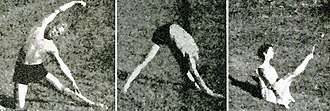Pārśvottānāsana
Pārśvottānāsana (Sanskrit: पार्श्वोत्तानासना) or Intense Side Stretch Pose is a standing and forward bending asana in modern yoga as exercise.

Etymology and origins

The name of the pose is from the Sanskrit प्रसव (parshva) meaning "side", ुत (ut) meaning "intense", तन (tan) meaning "to extend", and आस (asana), meaning "seat" or "pose".[3]
The pose is unknown in medieval hatha yoga, but is described in Krishnamacharya's 1935 Yoga Makaranda, and taken up by his pupils Pattabhi Jois and B. K. S. Iyengar in their respective schools of yoga.[4] A similar pose appears in Niels Bukh's 1924 Primary Gymnastics; Mark Singleton suggests that Krishnamacharya, influenced by the general gymnastics culture of the time, adopted gymnastics poses into his flowing style of yoga.[1][2]
Description
The pose is entered from Tadasana. The hands are pressed palms together in prayer position behind the back, fingertips upwards. The feet are placed about a leg length apart, both legs remaining straight. The forward foot points directly forwards; the rear foot is turned forwards some 60 degrees. The hips are aligned at right angles to the feet, so that the body can move downwards in a forward bend straight over the front leg.[5][3] The hands may be taken to the floor to intensify the stretch.[6]
References
- Bukh, Niels (2010) [1924]. Primary Gymnastics. Tufts Press. ISBN 978-1446527351.
- Singleton, Mark (2010). Yoga body : the origins of modern posture practice. Oxford University Press. pp. 161, 200–203. ISBN 978-0-19-539534-1. OCLC 318191988.
- Mehta 1990, pp. 40–41.
- Sjoman, Norman E. (1999) [1996]. The Yoga Tradition of the Mysore Palace. Abhinav Publications. pp. 100–102. ISBN 81-7017-389-2.
- Iyengar 1979, pp. 78–80.
- YJ Editors (28 August 2007). "Intense Side Stretch Pose". Yoga Journal.
Sources
- Iyengar, B. K. S. (1979) [1966]. Light on Yoga: Yoga Dipika. Unwin Paperbacks.CS1 maint: ref=harv (link)
- Mehta, Silva; Mehta, Mira; Mehta, Shyam (1990). Yoga: The Iyengar Way. Dorling Kindersley.CS1 maint: ref=harv (link)
- Mittra, Dharma (2003). Asanas: 608 Yoga Poses. ISBN 978-1-57731-402-8.
- Rhodes, Darren (2016). Yoga Resource Practice Manual. Tirtha Studios. ISBN 978-0983688396.
_from_Jogapradipika_1830_(detail).jpg)
